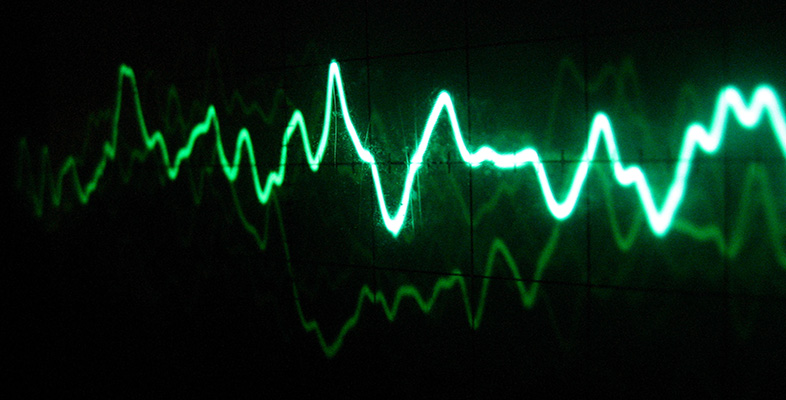2.2 Pressure in the atmosphere
The sounds we hear generally consist of rapid fluctuations of air pressure in the atmosphere that surrounds us. Sound can also be transmitted through other media, for instance water, so not all sound consists of fluctuations in air pressure. However, for the purposes of this discussion I shall confine myself to sound in air.
These fluctuations in air pressure are caused by a local disturbance to the air pressure, which might be sudden and transient – for example, when a paper bag is burst – or continuous and regular – for example, when someone sings a steady note. Whatever the nature of the disturbance, the pressure variations spread outwards from the source through the surrounding air, becoming gradually weaker. At a sufficient distance from the source, the pressure variations die away completely.
For a listener in the vicinity of the sound source, the pressure variations act on the listener's hearing mechanism, causing the eardrum to move in sympathy with the source of the pressure variations. The movements of the eardrum are detected by a mechanism in the middle ear, and are interpreted by the brain as sound.
The pressure variations we hear can also sometimes be felt. You may be familiar with the experience of holding an inflated balloon and feeling it vibrate in response to nearby sounds, or standing near a loudspeaker and feeling vibrations from the bass notes. In the case of the balloon, pressure variations cause the skin of the balloon to vibrate in just the same way as they cause the eardrum to vibrate. Similarly, all drummers and percussion players are familiar with the way drumskins resonate in sympathy with sound from nearby instruments, and often need to be damped to prevent unwanted noises being generated.
The air around us presses on everything it touches, and this is roughly what is meant by the atmospheric pressure. Generally we are unaware of the pressure because it acts equally in all directions, and so its effects are self-cancelling. However, if you removed some of the air from an empty, thin-walled plastic bottle, the pressures inside and outside the bottle would cease to be self-cancelling, and the bottle would buckle (Figure 2). The kinds of pressure imbalance that would make a plastic bottle buckle are, however, much larger than the pressure fluctuations associated with sound.

With regard to sound and the way it travels, we need to think about pressure in relation to the arrangement of molecules in the air. Atmospheric air is a mixture of gases, and at the submicroscopic scale consists of a mixture of gas molecules. These molecules are so tiny that they are only detectable individually by sophisticated scientific apparatus. In a moderately sized volume of air, such as inside a bottle, there is a colossal number of such molecules, and between them there is empty space. The molecules are not static, but continually move around, bouncing off other molecules or off any solid or liquid objects in their vicinity. In general, if there is no sound or other disturbance to the pressure of a sample of air, the molecules are evenly (though randomly) distributed throughout the sample.
The pressure of air (or any gas) is related to how closely packed its molecules are (Figure 3). If the molecules are widely dispersed, the pressure is lower than when they are closer together – other things being equal (principally temperature).

When you pump up a bicycle tyre, by driving more air into the tyre you squash the molecules together more closely than they are outside the tyre. Hence the pressure inside the tyre is higher than that outside.
The message to remember from this section is that sound consists of rapid fluctuations of atmospheric pressure, and that, at the molecular level, high pressure corresponds to air molecules being bunched together, and low pressure corresponds to air molecules being relatively widely separated.
Activity 5 (Self-Assessment)
The science fiction film Alien (1979) was promoted with the grim slogan, ‘In space, no one can hear you scream’. Is this slogan true in the following cases?
(a) In a space craft where there is an artificial atmosphere to sustain the crew.
(b) Outside the space craft, where there is a vacuum and the crew need to wear space suits to survive.
(c) On a planet where there is a poisonous atmosphere and where the crew need to wear space suits (which are not soundproof).
Answer
(a) Sound would be conveyed by the atmosphere within the craft, so the slogan does not apply here.
(b) In the vacuum of space there is no medium within which there can be pressure fluctuations, so the slogan applies here.
(c) The atmosphere on the planet would be able to sustain pressure variations, so the slogan does not apply here.
